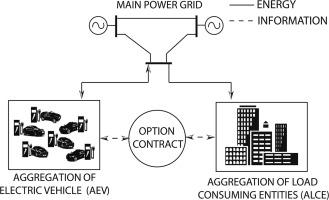当前位置:
X-MOL 学术
›
Int. J. Electr. Power Energy Sys.
›
论文详情
Our official English website, www.x-mol.net, welcomes your
feedback! (Note: you will need to create a separate account there.)
A Nash-bargaining model for trading of electricity between aggregations of peers
International Journal of Electrical Power & Energy Systems ( IF 5.0 ) Pub Date : 2020-12-01 , DOI: 10.1016/j.ijepes.2020.106185 Kevin A. Melendez , Tapas K. Das , Changhyun Kwon
International Journal of Electrical Power & Energy Systems ( IF 5.0 ) Pub Date : 2020-12-01 , DOI: 10.1016/j.ijepes.2020.106185 Kevin A. Melendez , Tapas K. Das , Changhyun Kwon

|
Abstract In the last several years, the growth in household solar generation and the lack of success of the feed-in-tariff programs have led to the rise of peer-to-peer (P2P) energy trading schemes among prosumers. However, a change that has started more recently is the growth of smart homes and businesses, of which loads are IoT controlled and are supported by advanced metering infrastructure (AMI). This has created a new opportunity for smart homes and businesses to form aggregations (coalitions) and participate in cooperative load management and energy trading. Unlike energy trading among individual prosumers in most P2P networks, a new trading opportunity that is emerging is between aggregations of peers of smart homes and businesses and electric vehicles (EVs). In this paper, we consider one such trading scenario between two aggregations, of which one has smart homes and businesses with load consuming entities (not prosumers), and the other has EVs only. The aggregation with smart homes and businesses derive cost reduction through optimal load scheduling based on load preferences, market-based pricing of electricity, and opportunity to trade (buy) energy from the aggregation with EVs. Whereas the aggregation of EVs optimally schedules charging to meet EV needs and uses stored energy to trade (sell). A generalized Nash bargaining model is developed for obtaining optimal trading strategies in the form of plain or swing option contracts. A sample numerical problem scenario is used to show that suitable contracts can be derived that allow aggregations of peers to mutually benefit from energy trading.It is shown that there exist numerous alternative optimal solutions to the Nash bargaining problem. The solutions comprise different combinations of strike price and option value, for all of which savings to the parties remain constant. For plain option, with a contract quantity of 1 MWh, the total savings generated is equivalent to the average price of 1.62 MWh of electricity. Interactions among contract parameters (such as strike price, option value, and option quantity) and the relative market power of the aggregations are also examined.
中文翻译:

用于在同行聚合之间进行电力交易的纳什讨价还价模型
摘要 在过去几年中,家庭太阳能发电的增长和上网电价计划的失败导致了产消者之间的点对点 (P2P) 能源交易计划的兴起。然而,最近开始的一个变化是智能家居和企业的增长,其中负载由物联网控制并由高级计量基础设施 (AMI) 提供支持。这为智能家居和企业形成聚合(联盟)并参与协作负载管理和能源交易创造了新的机会。与大多数 P2P 网络中个体消费者之间的能源交易不同,正在出现的新交易机会是在智能家居和企业与电动汽车 (EV) 的同行之间的聚合。在本文中,我们考虑了两个聚合之间的一个这样的交易场景,其中一个拥有智能家居和具有负载消耗实体(非产消者)的企业,另一个只有电动汽车。与智能家居和企业的聚合通过基于负载偏好、基于市场的电力定价以及从与电动汽车的聚合进行交易(购买)能源的机会的最佳负载调度来降低成本。而电动汽车的聚合可以最佳地安排充电以满足电动汽车的需求,并使用储存的能量进行交易(销售)。一个广义的纳什讨价还价模型被开发用于以普通或摆动期权合约的形式获得最佳交易策略。一个示例数值问题场景用于表明可以推导出合适的合同,允许对等方的聚合从能源交易中互惠互利。结果表明,对于纳什讨价还价问题,存在多种替代最优解。解决方案包括执行价格和期权价值的不同组合,所有这些组合为各方节省的费用保持不变。对于普通选项,合同量为 1 MWh,产生的总节能量相当于 1.62 MWh 的平均电力价格。合同参数(例如执行价格、期权价值和期权数量)和聚合的相对市场力量之间的相互作用也被检查。
更新日期:2020-12-01
中文翻译:

用于在同行聚合之间进行电力交易的纳什讨价还价模型
摘要 在过去几年中,家庭太阳能发电的增长和上网电价计划的失败导致了产消者之间的点对点 (P2P) 能源交易计划的兴起。然而,最近开始的一个变化是智能家居和企业的增长,其中负载由物联网控制并由高级计量基础设施 (AMI) 提供支持。这为智能家居和企业形成聚合(联盟)并参与协作负载管理和能源交易创造了新的机会。与大多数 P2P 网络中个体消费者之间的能源交易不同,正在出现的新交易机会是在智能家居和企业与电动汽车 (EV) 的同行之间的聚合。在本文中,我们考虑了两个聚合之间的一个这样的交易场景,其中一个拥有智能家居和具有负载消耗实体(非产消者)的企业,另一个只有电动汽车。与智能家居和企业的聚合通过基于负载偏好、基于市场的电力定价以及从与电动汽车的聚合进行交易(购买)能源的机会的最佳负载调度来降低成本。而电动汽车的聚合可以最佳地安排充电以满足电动汽车的需求,并使用储存的能量进行交易(销售)。一个广义的纳什讨价还价模型被开发用于以普通或摆动期权合约的形式获得最佳交易策略。一个示例数值问题场景用于表明可以推导出合适的合同,允许对等方的聚合从能源交易中互惠互利。结果表明,对于纳什讨价还价问题,存在多种替代最优解。解决方案包括执行价格和期权价值的不同组合,所有这些组合为各方节省的费用保持不变。对于普通选项,合同量为 1 MWh,产生的总节能量相当于 1.62 MWh 的平均电力价格。合同参数(例如执行价格、期权价值和期权数量)和聚合的相对市场力量之间的相互作用也被检查。











































 京公网安备 11010802027423号
京公网安备 11010802027423号